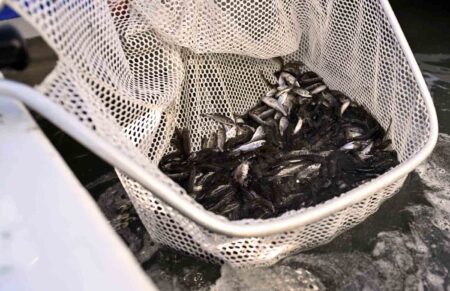It started off as your typical “let’s go fishing” kind of week for my 13-year-old daughter, Hannah, the youngest of my four children. I’ve been working with the Florida Fish and Wildlife Conservation Commission (FWC) for 29 years, and my family has spent time on the water and in the woods. Our experiences are golden to me, and each one is unique.
As Friday came around, the night-before checklist was completed: batteries charged, poles, tackle and PFDs loaded in the boat, fuel and oil topped off, and the trailer hooked to the truck.
I woke up extra early to double-check the weather, which looked to be perfect. We loaded up and headed to the boat ramp before the morning rush and started our journey toward our desired fishing spot, which happens to be several miles out from the ramp in the Gulf of Mexico. Manatee and other marine life sightings heightened the excitement.
As we arrived, I caught the sun rising, its rays dancing on the water. About that time I heard Hannah say, “What a beautiful day, Daddy.” The smile on her face was what memories are made from, even if we didn’t catch a single fish. She casted and her smile grew even bigger with anticipation of what might bite. We’d been talking all morning about having fresh seafood for dinner.
Fish on! We started catching black sea bass and spotted seatrout, but unfortunately they were all under the minimum size limit, so we released them to be caught another day. What we caught the most of was saltwater catfish.
As I threw yet another catfish back, Hannah asked me an interesting question, why did I throw the saltwater catfish back, when I keep the freshwater catfish we get. I couldn’t give her a good answer, except that I’ve always been told they’re not fit to eat and are only used for bait. Her remark puzzled me though, and as I’m always up for trying something new and adventurous, I kept the next good eating-size catfish, about a 1-pounder, and placed it on ice. We later caught a nice legal black sea bass to join the hardhead catfish in the cooler, ending our fishing day on a good note.
There are two primary types of saltwater catfish people typically catch, by the way: the hardhead, which is brownish to gray-green with four barbels on the chin, and the less common gafftopsail, which is more blue on the top and only has two barbels on the chin. Neither of the species are the same as the two primary freshwater catfish species: the channel and the flathead catfish. The state record for a hardhead catfish is 3 pounds, 5 ounces, and the record for a gafftopsail is 8 pounds, 14 ounces.

 There are no seasons or minimum size limits for either species of saltwater catfish, but there is a daily bag limit of 100 pounds. Visit MyFWC.com/Fishing and click on “Saltwater” and “Unregulated Species” for more on such species.
There are no seasons or minimum size limits for either species of saltwater catfish, but there is a daily bag limit of 100 pounds. Visit MyFWC.com/Fishing and click on “Saltwater” and “Unregulated Species” for more on such species.
Watch for the spines. I’ve had the opportunity to work in several different divisions during my career with FWC, one of which was Freshwater Fisheries. During my time there, I’ve been stuck and jabbed by freshwater catfish with little to no pain, but let me tell you, I made the unpleasant mistake of getting stuck by a saltwater cat on this trip and it lit me up. It was comparable to a scorpion or wasp sting. I didn’t show my pain because I didn’t want Hannah to worry, and I think that made it hurt worse. So I caution folks to pay attention and be careful when handling these fish, especially near the dorsal fin on the top of the fish and the two pectoral fins, where the barbs are located. The pain eventually went away, but I’m glad it was me and not my daughter, because that could’ve ruined a perfectly good day.
The trip home was filled with laughter and a discussion about how we were going to cook our catch.
Now comes one of my favorite parts of a fishing trip; the cooking and eating. I took the sea bass fillets and blackened them to perfection in my cast iron skillet. Then it was time for the catfish fillets, which I dusted in Zatarain’s Fish Fri Southern Crispy Style Frying Mix. I took the lightly covered fillets and placed them in the 350-degree oil until crisp on both sides. Hannah prepared a few side dishes, set the table and dinner was served.
With both fish carefully divided and placed on a plate, it was time to see what the fuss was all about. The sea bass lived up to its reputation of being a special treat and a savory eating fish. Enthusiastic to try the catfish, we both took a bite and looked at each other. Wow, it was awesome! Who knew! The catfish turned out to be a great tasting catch – mild, flaky and delicious. I’ll be keeping my share from now on. It actually had a better taste and texture than freshwater cats. I’m sold and can’t wait to catch some more so I can share with my coworkers.
I’ve definitely learned not to judge a fish based on what people say about it. Just like fishing, you have to try it for yourself.
Share your fishing photos and stories with us with by emailing them to Saltwater@MyFWC.com. Learn more about our photo requirements by visiting MyFWC.com/Fishing and clicking on “Saltwater” and “Ethical Angler Photo Recognition Program” at the bottom of the page. Don’t forget to record all of your catches on the iAngler phone app or at www.snookfoundation.org/data.html.
Gone Coastal article by Greg Workman



